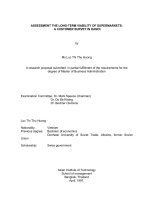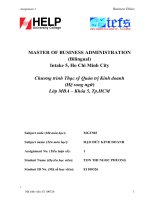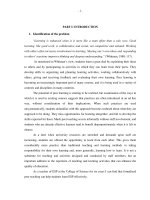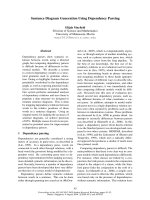MASTER OF SCIENCE (PHARMACY)
Bạn đang xem bản rút gọn của tài liệu. Xem và tải ngay bản đầy đủ của tài liệu tại đây (1.74 MB, 222 trang )
IN VITRO RELEASE OF KETOPROFEN FROM PROPRIETARY AND
EXTEMPORANEOUSLY MANUFACTURED GELS
A Thesis Submitted to Rhodes University in
Fulfilment of the Requirements for the Degree of
MASTER OF SCIENCE (PHARMACY)
by
Ralph Nii Okai Tettey-Amlalo
December 2005
Faculty of Pharmacy
Rhodes University
Grahamstown
i
ABSTRACT
Ketoprofen is a potent non-steroidal anti-inflammatory drug which is used for the treatment
of rheumatoid arthritis. The oral administration of ketoprofen can cause gastric irritation and
adverse renal effects. Transdermal delivery of the drug can bypass gastrointestinal
disturbances and provide relatively consistent drug concentrations at the site of
administration.
The release of ketoprofen from proprietary gel products from three different countries was
evaluated by comparing the in vitro release profiles. Twenty extemporaneously prepared
ketoprofen gel formulations using Carbopol® polymers were manufactured. The effect of
polymer, drug concentration, pH and solvent systems on the in vitro release of ketoprofen
from these formulations were investigated. The gels were evaluated for drug content and pH.
The release of the drug from all the formulations obeyed the Higuchi principle.
Two static FDA approved diffusion cells, namely the modified Franz diffusion cell and the
European Pharmacopoeia diffusion cell, were compared by measuring the in vitro release rate
of ketoprofen from all the gel formulations through a synthetic silicone membrane.
High-performance liquid chromatography and ultraviolet spectrophotometric analytical
techniques were both used for the analysis of ketoprofen. The validated methods were
employed for the determination of ketoprofen in the sample solutions taken from the receptor
fluid.
Two of the three proprietary products registered under the same manufacturing license
exhibited similar results whereas the third product differed significantly. Among the
variables investigated, the vehicle pH and solvent composition were found have the most
significant effect on the in vitro release of ketoprofen from Carbopol® polymers. The
different grades of Carbopol® polymers showed statistically significantly different release
kinetics with respect to lag time.
When evaluating the proprietary products, both the modified Franz diffusion cell and the
European Pharmacopoeia diffusion cell were deemed adequate although higher profiles were
generally obtained from the European Pharmacopoeia diffusion cells.
ii
Smoother diffusion profiles were obtained from samples analysed by high-performance liquid
chromatography than by ultraviolet spectrophotometry in both diffusion cells. Sample
solutions taken from Franz diffusion cells and analysed by ultraviolet spectrophotometry also
produced smooth diffusion profiles. Erratic and higher diffusion profiles were observed with
samples taken from the European Pharmacopoeia diffusion cell and analysed by ultraviolet
spectrophotometry.
The choice of diffusion cells and analytical procedure in product development must be
weighed against the relatively poor reproducibility as observed with the European
Pharmacopoeia diffusion cell.
iii
ACKNOWLEDGEMENT
I would like to sincerely thank the following people:
My supervisor, Professor John Michael Haigh, for giving me this opportunity to undertake
my research study with him and for his guidance, encouragement and financial support. I
would also like to thank his wife, Mrs Lil Haigh for the keen interest and trust she has in me.
Mr Dave Morley, Mr Leon Purdon and Mr Tichaona Samkange for their advice, assistance
and technical expertise in the laboratory and to Mrs Prudence Mzangwa for ensuring the
tidiness of the laboratory.
The Dean and Head, Professor Isadore Kanfer and the staff of the Faculty of Pharmacy for
the use of departmental facilities.
Professor Roger Verbeeck for giving me his book on Dermatological and Transdermal
Formulations and GraphPad PRISM® statistical software.
My colleagues in the Faculty for their friendship and support.
Sigma-Aldrich (Atlasville, South Africa) for the donation of ketoprofen which was facilitated
by Professor Rod Bryan Walker.
Aspen Pharmacare (Port Elizabeth, South Africa), Gattefossé (Saint-Priest, France), Noveon
Inc. (Cleveland, USA) for the donation of excipients.
My parents, especially my Father, who has always believed in me and taught me the true
meaning of hard work.
Finally I would like to give thanks to the Almighty God for strength, determination and
power to succeed no matter what storms or challenges life brings my way. I would also like
to thank him for the life of my son.
iv
STUDY OBJECTIVES
Ketoprofen is a non-steroidal anti-inflammatory, analgesic and antipyretic drug used for the
treatment of rheumatoid osteoarthritis, ankylosing spondylitis and gout. It is more potent
than the other non-steroidal anti-inflammatory drugs (NSAIDs) with respect to some effects
such as anti-inflammatory and analgesic activities.
Although ketoprofen is rapidly absorbed, metabolized and excreted, it causes some
gastrointestinal complaints such as nausea, dyspepsia, diarrhoea, constipation and some renal
side effects like other NSAIDs. Therefore, there is a great interest in developing topical
dosage forms of these NSAIDs to avoid the oral side effects and provide relatively consistent
drug concentrations at the application site for prolonged periods.
The objectives of this study were:
1. To develop and validate a suitable high-performance liquid chromatographic method
for the determination of ketoprofen from topical gel formulations.
2. To develop and validate a suitable ultraviolet spectrophotometric method for the
determination of ketoprofen from topical gel formulations.
3. To extemporaneously manufacture topical gel formulations using Carbopol® polymers
and study the effect of polymer type, pH, loading concentration and solvent
composition on the in vitro release of ketoprofen.
4. To compare and contrast the in vitro release rates of ketoprofen from proprietary gel
products and extemporaneously prepared topical gel formulations using the Franz
diffusion cell and the European Pharmacopoeia diffusion cell.
5. To compare and contrast the in vitro release rates of different proprietary gel products
and extemporaneously prepared topical gel formulations using ultraviolet
spectrophotometry and high-performance liquid chromatography utilizing both the
Franz diffusion cell and the European Pharmacopoeia diffusion cell.
v
TABLE OF CONTENTS
ABSTRACT................................................................................................................................... ii
ACKNOWLEDGEMENT........................................................................................................... iv
STUDY OBJECTIVES................................................................................................................. v
TABLE OF CONTENTS ............................................................................................................ vi
LIST OF TABLES ...................................................................................................................... xii
LIST OF FIGURES ................................................................................................................... xiii
CHAPTER ONE ........................................................................................................................... 1
TRANSDERMAL DRUG DELIVERY ...................................................................................... 1
1.1
PAST PROGRESS, CURRENT STATUS AND FUTURE PROSPECTS OF
TRANSDERMAL DRUG DELIVERY ...................................................................... 1
1.1.1
1.1.2
1.1.3
1.1.4
1.2
Introduction........................................................................................................1
Rationale for transdermal drug delivery ............................................................2
Advantages and drawbacks of transdermal drug delivery .................................2
Innovations in transdermal drug delivery ..........................................................5
PERCUTANEOUS ABSORPTION ............................................................................ 6
1.2.1
1.2.2
1.2.2.1
1.2.2.2
1.2.2.3
1.2.2.4
1.2.3
1.2.3.1
1.2.3.2
1.2.3.3
1.2.4
1.2.5
1.2.5.1
1.2.5.1.1
1.2.5.2
1.2.5.2.1
1.2.5.2.2
1.2.5.2.3
1.2.5.2.4
1.2.5.2.5
1.2.5.2.6
1.2.5.2.7
Introduction........................................................................................................6
Human skin ........................................................................................................7
Structure and functions of skin ..........................................................................7
The epidermis.....................................................................................................8
The viable epidermis........................................................................................10
The dermis .......................................................................................................10
Routes of drug permeation across the skin ......................................................10
Transcellular pathway......................................................................................11
Intercellular pathway .......................................................................................11
Appendageal pathway......................................................................................12
Barrier function of the skin ..............................................................................13
Enhancing transdermal drug delivery ..............................................................14
Chemical approach...........................................................................................14
Chemical penetration enhancers ..................................................................16
Physical approach ............................................................................................17
Iontophoresis................................................................................................17
Electroporation.............................................................................................19
Phonophoresis ..............................................................................................20
Microneedle .................................................................................................22
Pressure waves .............................................................................................23
Other approaches .........................................................................................23
Synergistic effect of enhancers ....................................................................24
vi
1.2.6
1.2.6.1
1.2.6.1.1
1.2.6.1.2
1.2.6.1.3
1.2.7
1.2.7.1
1.2.7.2
1.2.7.3
1.3
MATHEMATICAL PRINCIPLES IN TRANSMEMBRANE DIFFUSION........ 27
1.3.1
1.3.2
1.3.2.1
1.3.2.2
1.3.3
1.4
Selection of drug candidates for transdermal drug delivery ............................24
Biological properties of the drug .....................................................................25
Potency.........................................................................................................25
Half-life........................................................................................................25
Toxicity ........................................................................................................25
Physicochemical properties of the drug...........................................................25
Oil-water partition co-efficient ........................................................................25
Solubility and molecular dimensions...............................................................26
Polarity and charge ..........................................................................................26
Introduction......................................................................................................27
Fickian model...................................................................................................27
Fick’s first law of diffusion..............................................................................27
Fick’s second law of diffusion.........................................................................28
Higuchi model..................................................................................................30
METHODS FOR STUDYING PERCUTANEOUS ABSORPTION ..................... 32
1.4.1
1.4.2
1.4.2.1
1.4.2.2
Introduction......................................................................................................32
Diffusion cell design ........................................................................................32
Franz and modified Franz diffusion cell..........................................................33
European Pharmacopoeia diffusion cell ..........................................................34
CHAPTER TWO ........................................................................................................................ 36
KETOPROFEN MONOGRAPH .............................................................................................. 36
2.1
PHYSICOCHEMICAL PROPERTIES OF KETOPROFEN................................ 36
2.1.1
2.1.2
2.1.3
2.1.4
2.1.5
2.1.6
2.1.7
2.1.8
2.1.9
2.1.10
2.1.11
2.1.12
2.1.13
2.1.14
Introduction......................................................................................................36
Description.......................................................................................................36
Stereochemistry................................................................................................37
Melting point....................................................................................................37
Solubility..........................................................................................................37
Dissociation constant .......................................................................................38
Maximum flux .................................................................................................38
Partition co-efficient and permeability co-efficient.........................................38
Optical rotation ................................................................................................38
Synthesis ..........................................................................................................39
Stability ............................................................................................................42
Ultraviolet absorption ......................................................................................43
Infrared spectrum .............................................................................................43
Nuclear magnetic resonance spectrum.............................................................43
vii
2.2
CLINICAL PHARMACOLOGY OF KETOPROFEN .......................................... 45
2.2.1
2.2.2
2.2.3
2.2.4
2.2.4.1
2.2.4.2
2.2.5
2.2.6
2.2.7
2.2.8
2.3
Anti-inflammatory effects................................................................................45
Analgesic and antipyretic effects .....................................................................45
Mechanism of action........................................................................................45
Therapeutic use ................................................................................................47
Indications........................................................................................................47
Contraindications .............................................................................................47
Adverse reactions.............................................................................................48
Toxicology .......................................................................................................49
Drug interactions..............................................................................................50
Pharmaceutics ..................................................................................................51
PHARMACOKINETICS OF TOPICAL KETOPROFEN .................................... 52
CHAPTER THREE .................................................................................................................... 56
IN VITRO ANALYSIS OF KETOPROFEN ............................................................................ 56
3.1
DEVELOPMENT AND VALIDATION OF AN HIGH-PERFORMANCE
LIQUID CHROMATOGRAPHIC METHOD FOR THE DETERMINATION
OF KETOPROFEN .................................................................................................... 56
3.1.1
3.1.1.1
3.1.1.2
3.1.1.2.1
3.1.1.2.2
3.1.1.2.3
3.1.1.2.4
3.1.1.2.5
3.1.1.2.6
3.1.1.2.7
3.1.1.3
3.1.1.3.1
3.1.1.3.2
3.1.1.3.3
3.1.1.4
3.1.1.5
3.1.2
3.1.2.1
3.1.2.2
3.1.2.3
3.1.2.3.1
3.1.2.3.2
3.1.2.3.3
3.1.2.4
3.1.2.5
Method development .......................................................................................56
Introduction......................................................................................................56
Experimental ....................................................................................................57
Reagents.......................................................................................................57
Instrumentation ............................................................................................57
Ultraviolet detection.....................................................................................59
Column selection .........................................................................................59
Mobile phase selection.................................................................................61
Preparation of selected mobile phase...........................................................62
Preparation of stock solutions......................................................................63
Optimisation of the chromatographic conditions.............................................63
Detector wavelength ....................................................................................63
Choice of column.........................................................................................63
Mobile phase composition ...........................................................................64
Chromatographic conditions............................................................................65
Conclusion .......................................................................................................65
Method validation ............................................................................................66
Introduction......................................................................................................66
Accuracy and bias ............................................................................................66
Precision...........................................................................................................67
Repeatability ................................................................................................67
Intermediate precision..................................................................................68
Reproducibility ............................................................................................68
Specificity and selectivity ................................................................................69
Limit of detection and limit of quantitation.....................................................69
viii
3.1.2.6
3.1.2.7
3.1.2.8
3.2
Linearity and range ..........................................................................................70
Sample solution stability..................................................................................71
Conclusion .......................................................................................................72
DEVELOPMENT AND VALIDATION OF AN ULTRAVIOLET
SPECTROPHOTOMETRIC METHOD FOR THE DETERMINATION OF
KETOPROFEN........................................................................................................... 73
3.2.1
3.2.1.1
3.2.1.2
3.2.1.2.1
3.2.1.3
3.2.1.3.1
3.2.1.3.2
3.2.1.3.3
3.2.1.4
3.2.1.4.1
3.2.1.4.2
3.2.1.4.3
3.2.1.4.4
3.2.1.5
3.2.2
3.2.2.1
3.2.2.2
3.2.2.2.1
3.2.2.2.2
3.2.2.2.3
3.2.2.3
3.2.2.4
3.2.2.5
3.1.2.6
Method development .......................................................................................73
Introduction......................................................................................................73
Principles of ultraviolet-visible absorption spectroscopy ................................73
Beer-Lambert law ........................................................................................73
Experimental ....................................................................................................76
Reagents.......................................................................................................76
Instrumentation ............................................................................................76
Preparation of stock solutions......................................................................76
Optimization of spectrophotometric conditions...............................................76
Solvent .........................................................................................................76
Ultraviolet detection.....................................................................................77
Concentration of solute ................................................................................77
Spectrophotometric conditions ....................................................................77
Conclusion .......................................................................................................77
Method validation ............................................................................................78
Accuracy and bias ............................................................................................78
Precision...........................................................................................................78
Repeatability ................................................................................................78
Intermediate precision..................................................................................78
Reproducibility ............................................................................................79
Limit of detection and limit of quantitation.....................................................79
Linearity and range ..........................................................................................79
Sample solution stability..................................................................................80
Conclusion .......................................................................................................80
CHAPTER FOUR....................................................................................................................... 81
THE IN VITRO RELEASE OF KETOPROFEN .................................................................... 81
4.1
IN VITRO DISSOLUTION METHODOLOGY ...................................................... 81
4.1.1
4.1.2
4.1.2.1
4.1.2.2
4.1.2.3
4.1.2.4
4.1.2.5
4.1.2.6
4.1.2.7
4.1.2.8
Introduction......................................................................................................81
In vitro release testing......................................................................................82
Diffusion cell system .......................................................................................82
Synthetic membrane.........................................................................................83
Receptor medium .............................................................................................83
Sample applications .........................................................................................86
Number of samples ..........................................................................................87
Sampling time ..................................................................................................88
Sample analysis................................................................................................88
Diffusion profile comparison...........................................................................88
ix
CHAPTER FIVE ........................................................................................................................ 90
FORMULATIONS OF PROPRIETARY AND EXTEMPORANEOUS TOPICAL
KETOPROFEN GEL PREPARATIONS USING CARBOPOL® POLYMERS AND
CO-POLYMERS......................................................................................................................... 90
5.1
DERMATOLOGICAL FORMULATIONS............................................................. 90
5.1.1
5.1.2
5.1.2.1
5.1.2.2
5.1.2.3
5.2
EXCIPIENTS .............................................................................................................. 94
5.2.1
5.2.2
5.2.3
5.2.4
5.2.5
5.3
Proposed design ...............................................................................................99
Preliminary studies...........................................................................................99
Preparation of extemporaneous topical gel formulations ................................99
Physical characterization of extemporaneous topical gel formulations.........100
Drug content...................................................................................................100
pH...................................................................................................................102
Viscosity ........................................................................................................102
In vitro dissolution studies .............................................................................102
DIFFUSION PROFILES AND RELEASE KINETIC DATA OF
PROPRIETARY KETOPROFEN CONTAINING TOPICAL GEL
PREPARATIONS FROM THREE COUNTRIES ................................................ 103
5.4.1
5.4.2
5.4.2.1
5.4.2.2
5.4.2.3
5.4.3
5.4.4
5.5
Gelling agents ..................................................................................................94
Triethanolamine ...............................................................................................97
Propylene glycol ..............................................................................................97
Ethanol .............................................................................................................97
Transcutol® HP ................................................................................................97
EXPERIMENTAL...................................................................................................... 99
5.3.1
5.3.2
5.3.3
5.3.4
5.3.4.1
5.3.4.2
5.3.4.3
5.3.4.4
5.4
Introduction......................................................................................................90
Formulation of dermatological products..........................................................91
Ointments.........................................................................................................91
Gels ..................................................................................................................92
Emulsions.........................................................................................................93
Introduction....................................................................................................103
Results............................................................................................................104
Composition of proprietary products .............................................................104
Drug content and pH readings .......................................................................105
In vitro release of ketoprofen.........................................................................106
Discussion ......................................................................................................108
Conclusion .....................................................................................................110
DIFFUSION PROFILES AND RELEASE KINETIC DATA OF
EXTEMPORANEOUS TOPICAL KETOPROFEN GEL PREPARATIONS
USING CARBOPOL® POLYMERS AND CO-POLYMERS.............................. 111
5.5.1
5.5.2
Introduction....................................................................................................111
Results............................................................................................................112
x
5.5.2.1
5.5.2.2
5.5.2.3
5.5.2.4
5.5.2.5
5.5.2.6
5.5.3
5.5.4
5.6
COMPARISON OF DIFFUSION STUDIES OF KETOPROFEN BETWEEN
THE FRANZ DIFFUSION CELL AND THE EUROPEAN
PHARMACOPOEIA DIFFUSION CELL ............................................................. 135
5.6.1
5.6.2
5.6.3
5.6.4
5.7
Effect of different grades of Carbopol® polymers and co-polymer...............114
Effect of polymer concentration ....................................................................116
Effect of ketoprofen concentration ................................................................118
Effect of vehicle pH .......................................................................................119
Effect of co-polymer concentration ...............................................................121
Effect of solvent systems ...............................................................................125
Discussion ......................................................................................................129
Conclusion .....................................................................................................134
Introduction....................................................................................................135
Results............................................................................................................136
Discussion ......................................................................................................140
Conclusion .....................................................................................................143
COMPARISON OF DIFFUSION STUDIES OF KETOPROFEN BETWEEN
HIGH-PERFORMANCE LIQUID CHROMATOGRAPHY AND
ULTRAVIOLET SPECTROPHOTOMETRY...................................................... 144
5.7.1
5.7.2
5.7.3
5.7.4
Introduction....................................................................................................144
Results............................................................................................................145
Discussion ......................................................................................................153
Conclusion .....................................................................................................154
APPENDIX I ............................................................................................................................. 155
APPENDIX II............................................................................................................................ 159
APPENDIX III .......................................................................................................................... 183
APPENDIX IV .......................................................................................................................... 189
REFERENCES.......................................................................................................................... 191
xi
LIST OF TABLES
Table 1.1
Comparison of methods to enhance transdermal delivery....................................23
Table 2.1 Major infrared band assignments of ketoprofen ...................................................43
Table 2.2 Published ketoprofen H1-NMR spectrum values..................................................43
Table 2.3 Ketoprofen formulations.......................................................................................51
Table 3.1
Table 3.2
Table 3.3
Table 3.4
Table 3.5
Table 3.6
Table 3.7
Table 3.8
Table 3.9
Table 3.10
Table 3.11
Table 3.12
Initial hplc studies employed in the method development for the analysis
of ketoprofen........................................................................................................58
The effect of mobile phase composition on the retention time of ketoprofen ......62
Effect of wavelength on the relative percent peak area of ketoprofen ................63
Optimal chromatographic conditions applied.......................................................65
Accuracy test results on blinded samples .............................................................67
Inter-day (repeatability) assessment on five concentrations.................................68
Intra-day assessment of five concentrations .........................................................68
Limit of quantification values assessed ................................................................70
Optimal spectrophotometric conditions applied ...................................................77
Accuracy test results on blinded samples of ketoprofen by uv analysis...............78
Inter-day (repeatability) assessment on five concentrations of ketoprofen
by uv analysis.......................................................................................................78
Intra-day assessment of five concentrations of ketoprofen by uv analysis...........79
Table 5.1 General classification and description of gels ......................................................92
Table 5.2 Common excipients employed and their sources .................................................98
Table 5.3 Summary of formulae used in the extemporaneous manufacture of
ketoprofen gels KET001 - KET010...................................................................101
Table 5.4 Summary of formulae used in the extemporaneous manufacture of
ketoprofen gels KET011 - KET020...................................................................101
Table 5.5 Summary of in vitro experimental conditions ....................................................102
Table 5.6 Detailed compositions of proprietary products as indicated on package............104
Table 5.7 Drug content uniformity and pH values of proprietary products........................105
Table 5.8 In vitro ketoprofen release kinetic data of proprietary products.........................108
Table 5.9 Drug content uniformity and pH values obtained for KET001 - KET020 .........112
Table 5.10 In vitro ketoprofen release kinetic data for KET001 - KET020 .........................113
Table 5.11 In vitro release data comparison between Franz and European
Pharmacopoeia diffusion cells ...........................................................................136
Table 5.12 Comparison of analytic procedure using Franz diffusion cells ..........................145
Table 5.13 Comparison of analytical procedure using European Pharmacopoeia
diffusion cells.....................................................................................................146
xii
LIST OF FIGURES
Figure 1.1 Components of the epidermis and dermis of human skin .....................................8
Figure 1.2 Epidermal differentiation.......................................................................................9
Figure 1.3 Schematic diagram of the potential routes of drug penetration through the
stratum corneum...................................................................................................12
Figure 1.4 Basic principle of iontophoresis ..........................................................................18
Figure 1.5 Basic principle of electroporation .......................................................................19
Figure 1.6 Basic principle of phonophoresis ........................................................................20
Figure 1.7 Basic design of microneedle delivery system devices ........................................22
Figure 1.8 Modified Franz diffusion cell..............................................................................34
Figure 1.9 European Pharmacopoeia diffusion cell..............................................................35
Figure 2.1
Figure 2.2
Figure 2.3
Figure 2.4
Figure 2.5
Figure 2.6
Figure 2.7
Figure 2.8
Figure 2.9
Figure 2.10
Structure of ketoprofen........................................................................................36
Stereochemistry of ketoprofen ............................................................................37
Synthesis of ketoprofen starting from (3-carboxy-phenyl)-2-propionitrile.........39
Synthesis of ketoprofen starting from 2-(4-aminophenyl)-propionic acid..........40
Synthesis of ketoprofen starting from (3-benzoylphenyl)-acetonitrile ...............41
Ketoprofen impurities and photodegradation products .......................................42
Ultraviolet spectrum of ketoprofen standard in aqueous solution.......................44
Infrared spectrum of ketoprofen..........................................................................44
Nuclear magnetic resonance spectrum of ketoprofen .........................................44
Metabolism of ketoprofen ...................................................................................55
Figure 3.1 Typical chromatogram of a standard solution of ketoprofen at 10 µg/ml
obtained using the chromatographic conditions specified ...................................65
Figure 3.2 Chromatographic representation of a buffered solution of Fastum® gel
formulation after exposure to light ......................................................................69
Figure 3.3 Calibration curve of ketoprofen...........................................................................71
Figure 3.4 Curves of ketoprofen aqueous solution (10 μg/ml) stability stored in the
dark at 4°C and on exposure to light at 25°C analysed by hplc...........................72
Figure 3.5 Calibration curve of ketoprofen by uv analysis...................................................79
Figure 3.6 Curves of ketoprofen aqueous solution (10 μg/ml) stored in the dark at
4°C and on exposure to light at 25°C analysed by uv .........................................80
Figure 4.1
Figure 4.2
Figure 4.3
Figure 5.1
Figure 5.2
Figure 5.3
Effect of molarity and pH on the diffusion profile of ketoprofen .......................85
Effect of temperature on the diffusion profile of ketoprofen ..............................86
Effect of mass on the diffusion profile of ketoprofen .........................................87
Diffusion profiles of proprietary products (n = 5) .............................................106
Higuchi plots of proprietary products (n = 5) ...................................................107
Diffusion profiles showing the effect of different grades of Carbopol®
polymers on the release of ketoprofen (n = 5) ..................................................114
Figure 5.4 Higuchi plots showing the effect of different grades of Carbopol®
polymers (n = 5) .................................................................................................115
Figure 5.5 Mean maximum fluxes and lag times obtained from the release kinetics
of ketoprofen from different grades of Carbopol® polymers (n = 5) ................115
xiii
Figure 5.6 Diffusion profiles showing the effect of different concentrations of
Carbopol® Ultrez™ 10 NF polymer on the release of ketoprofen (n = 5) ........116
Figure 5.7 Higuchi plots showing the effect of different concentrations of
Carbopol® Ultrez™ 10 NF polymer (n = 5) ......................................................117
Figure 5.8 Diffusion profiles showing the effect of drug concentration on the
release rate of ketoprofen (n = 5) ......................................................................118
Figure 5.9 Higuchi plots showing the effect of drug concentration on the release
rate of ketoprofen (n = 5) ..................................................................................119
Figure 5.10 Diffusion profiles showing the effect of pH on the release rate of
ketoprofen (n = 5) .............................................................................................120
Figure 5.11 Higuchi plots showing the effect of pH on the release rate of
ketoprofen (n = 5) .............................................................................................120
Figure 5.12 Relationship between the apparent fluxes of the formulations to the
amount of unionised drug present in each formulation (n = 5) ........................121
Figure 5.13 Diffusion profiles showing the effect of Pemulen® TR1 NF into
Carbopol® 980 NF formulations on the release rate of ketoprofen (n = 5) ......122
Figure 5.14 Higuchi plots showing the effect of Pemulen® TR1 NF into
Carbopol® 980 NF formulations on the release rate of ketoprofen (n = 5) ......122
Figure 5.15 Mean maximum fluxes and lag times obtained from the effect of
Pemulen® TR1 NF incorporated in Carbopol® 980 NF formulations (n = 5) ..123
Figure 5.16 Diffusion profiles comparing KET008 and Fastum® Gel (n = 5) ....................124
Figure 5.17 Comparisons of apparent fluxes and lag times obtained from KET008
and Fastum® Gel (n = 5) ...................................................................................124
Figure 5.18 Diffusion profiles showing the effect of solvent systems (n = 5) ....................125
Figure 5.19 Higuchi plots showing the effect of solvent systems (n = 5) ...........................126
Figure 5.20 Mean apparent fluxes and lag times obtained from the Transcutol® HP
formulations (n = 5) ..........................................................................................126
Figure 5.21 Mean apparent fluxes and lag times obtained from KET019 and
KET020 (n = 5) .................................................................................................127
Figure 5.22 Mean apparent fluxes and lag times obtained from KET002 and
KET018 (n = 5) .................................................................................................128
Figure 5.23 Mean apparent fluxes and lag times obtained from KET002 and
KET017 (n = 5) .................................................................................................128
Figure 5.24 Franz diffusion cell and European Pharmacopoeia diffusion cell comparison
of the in vitro release of ketoprofen from proprietary formulations (n = 5) .....137
Figure 5.25 Effect of different grades of Carbopol® polymers on the release of
ketoprofen from Franz diffusion cells and European Pharmacopoeia
diffusion cells (n = 5) ........................................................................................138
Figure 5.26 Effect of different concentration of Carbopol® Ultrez™ 10 NF polymer
on the release of ketoprofen from Franz diffusion cells and European
Pharmacopoeia diffusion cells (n = 5) ..............................................................138
Figure 5.27 Effect of drug concentration on the release of ketoprofen from Franz
diffusion cells and European Pharmacopoeia diffusion cells (n = 5) ...............139
Figure 5.28 Effect of pH on the release of ketoprofen from Franz diffusion cells and
European Pharmacopoeia diffusion cells (n = 5) ..............................................139
xiv
Figure 5.29 Effect of Pemulen® TR1 NF into Carbopol® 980 NF formulations on
the release of ketoprofen from Franz diffusion cells and European
Pharmacopoeia diffusion cells (n = 5) ..............................................................140
Figure 5.30 In vitro Franz cell diffusion profiles of proprietary products using hplc
and uv spectrophotometric analysis (n = 5) ......................................................147
Figure 5.31 In vitro European Pharmacopoeia cell diffusion profiles of proprietary
products using hplc and uv spectrophotometric analysis (n = 5) ......................147
Figure 5.32 Effect of different grades of Carbopol® polymers on the release of
ketoprofen using Franz diffusion cells with hplc and uv spectrophotometric
analysis (n = 5) ..................................................................................................148
Figure 5.33 Effect of different grades of Carbopol® polymers on the release of
ketoprofen using European Pharmacopoeia diffusion cells with hplc and
uv spectrophotometric analysis (n = 5) .............................................................148
Figure 5.34 Effect of different concentration of Carbopol® Ultrez™ 10 NF polymer
on the release of ketoprofen using Franz diffusion cells with hplc and uv
spectrophotometric analysis (n = 5) ..................................................................149
Figure 5.35 Effect of different concentration of Carbopol® Ultrez™ 10 NF polymer
on the release of ketoprofen using European Pharmacopoeia diffusion
cells with hplc and uv spectrophotometric analysis (n = 5) ..............................149
Figure 5.36 Effect of drug concentration on the release of ketoprofen using Franz
diffusion cells with hplc and uv spectrophotometric analysis (n = 5) ..............150
Figure 5.37 Effect of drug concentration on the release of ketoprofen using
European Pharmacopoeia diffusion cells with hplc and uv
spectrophotometric analysis (n = 5) ..................................................................150
Figure 5.38 Effect of pH on the release of ketoprofen using Franz diffusion cells
with hplc and uv spectrophotometric analysis (n = 5) ......................................151
Figure 5.39 Effect of pH on the release of ketoprofen using European Pharmacopoeia
diffusion cells with hplc and uv spectrophotometric analysis (n = 5) ..............151
Figure 5.40 Effect of incorporation of Pemulen® TR1 NF into Carbopol® 980 NF
formulations on the release of ketoprofen using Franz diffusion cells
with hplc and uv spectrophotometric analysis (n = 5) ......................................152
Figure 5.41 Effect of incorporation of Pemulen® TR1 NF into Carbopol® 980 NF
formulations on the release of ketoprofen using European Pharmacopoeia
diffusion cells with hplc and uv spectrophotometric analysis (n = 5) ..............152
xv
CHAPTER ONE
TRANSDERMAL DRUG DELIVERY
1.1
PAST PROGRESS, CURRENT STATUS AND FUTURE PROSPECTS OF
TRANSDERMAL DRUG DELIVERY
1.1.1
Introduction
Human beings have been placing salves, lotions and potions on their skin from ancient times
(1) and the concept of delivering drugs through the skin is a practice which dates as far back
as the 16th century BC (2). The Ebers Papyrus, the oldest preserved medical document,
recommended that the husk of the castor oil plant be crushed in water and placed on an
aching head and ‘the head will be cured at once, as though it had never ached’ (2). In the late
seventies transdermal drug delivery (TDD) was heralded as a methodology that could provide
blood drug concentrations controlled by a device and there was an expectation that it could
therefore develop into a universal strategy for the administration of medicines (3).
The transdermal route of controlled drug delivery is often dismissed as a relatively minor
player in modern pharmaceutical sciences. One commonly hears that the skin is too good a
barrier to permit the delivery of all but a few compounds and that transdermal transport is not
even worth the consideration for new drugs of the biotechnology industry (4). This has
however been disputed as today TDD is a well-accepted means of delivering many drugs to
the systemic circulation (2) in order to achieve a desired pharmacological outcome.
Traditional preparations used include ointments, gels, creams and medicinal plasters
containing natural herbs and compounds. The development of the first pharmaceutical
transdermal patch of scopolamine for motion sickness in the early 1980s heralded acceptance
of the benefits and applicability of this method of administration of modern commercial
products (4 - 6). The success of this approach is evidenced by the fact that there are currently
more than 35 TDD products approved in the USA for the treatment of conditions including
hypertension, angina, female menopause, severe pain states, nicotine dependence, male
hypogonadism, local pain control and more recently, contraception and urinary incontinence
(2 - 8, 55). Several products are in late-stage development that will further expand TDD
usage into new therapeutic areas, including Parkinson’s disease, attention deficit and
hyperactivity disorder and female dysfunction (5, 6). New and improved TDD products are
1
also under development that will expand the number of therapeutic options in pain
management, osteoporosis and hormone replacement (6). The current USA market for
transdermal patches is over $3 billion annually and for testosterone gel is approximately $225
million (7, 8, 55) and represents the most successful non-oral systemic drug delivery system
(27).
Clearly, the clinical benefits, industrial interest, strong market and regulatory precedence
show why TDD has become a successful and viable dosage form (6).
1.1.2
Rationale for transdermal drug delivery
Given that the skin offers such an excellent barrier to molecular transport, the rationale for
this delivery strategy needs to be carefully identified. There are several instances in which
the most convenient of drug intake methods (the oral route) is not feasible therefore
alternative routes must be sought. Although intravenous introduction of the medicament
avoids many of these shortfalls (such as gastrointestinal tract (GIT) and hepatic metabolism),
its invasive nature (particularly for chronic administration) has encouraged the search for
alternative strategies and few anatomical orifices have not been investigated for their
potential as optional drug delivery routes. The implementation of TDD technology must be
therapeutically justified. Drugs with high oral bioavailability and infrequent dosing regimens
that are well accepted by patients do not warrant such measures. Similarly, transdermal
administration is not a means to achieve rapid bolus-type drug inputs, rather it is usually
designed to offer slow, sustained drug delivery over substantial periods of time and, as such,
tolerance-inducing drugs or those (e.g., hormones) requiring chronopharmacological
management are, at least to date, not suitable. Nevertheless, there remains a large pool of
drugs for which TDD is desirable but presently unfeasible. The nature of the stratum
corneum (SC) is, in essence, the key to this problem. The excellent diffusional resistance
offered by the membrane means that the daily drug dose that can be systematically delivered
through a reasonable ‘patch-size’ area remains in the < 10 mg range (27). The structure and
barrier property of the SC are discussed in sections 1.2.2.1 and 1.2.4 respectively.
1.1.3
Advantages and drawbacks of transdermal drug delivery
The skin offers several advantages as a route for drug delivery and most of these have been
well documented (2 - 8, 27). In most cases, although the skin itself controls drug input into
2
the systemic circulation, drug delivery can be controlled predictably and over a long period of
time, from simple matrix-type transdermal patches (3). Transdermal drug systems provide
constant concentrations in the plasma for drugs with a narrow therapeutic window, thus
minimising the risk of toxic side effects or lack of efficacy associated with conventional oral
dosing (2). This is of great value particularly for drugs with short half-lives to be
administered at most once a day and which can result in improved patient compliance (2, 5).
In clinical drug therapies, topical application allows localized drug delivery to the site of
interest. This enhances the therapeutic effect of the drug while minimising systemic side
effects (11). The problems associated with first-pass metabolism in the GIT and the liver are
avoided with TDD and this allows drugs with poor oral bioavailability to be administered at
most once a day and this can also result in improved patient compliance (2, 3, 12, 37).
Transdermal administration avoids the vagaries of the GIT milieu and does not shunt the drug
directly through the liver (1). How much of a problem exists is very dependant on the
properties of the medicinal agent, but it should be remembered that the skin is capable of
metabolising some permeants (3, 38). The deeper layers of the skin are metabolically more
active than the SC. Although the SC is considered to be a dead layer, it has been established
that microflora present on the skin surface are capable of metabolising drugs (9, 38). The
GIT tract presents a fairly hostile environment to a drug molecule. The low gastric pH or
enzymes may degrade a drug molecule, or the interaction with food, drinks and/or other drugs
in the stomach may prevent the drug from permeating through the GIT wall (1). The
circumvention of the drug from the hostile environment of the GIT minimises possible gastric
irritation and chemical degradation or systemic deactivation of the drug (2, 11, 37). Unlike
parenteral, subcutaneous and intramuscular formulations, a transdermal product does not
have the stigma associated with needles nor does it require professional supervision for
administration (1, 2, 27). This increases patient acceptance (1, 3) and allows ambulatory
patients to leave the hospital while on medication. In the case of an adverse reaction or
overdose, the patient can simply remove the transdermal device without undergoing the harsh
antidote treatment of having the stomach pumped (1, 12, 37). An additional benefit that has
been noted in hospitals is the ability of the nurse or physician to tell that the patient is on a
particular drug, since the transdermal is worn on the person and can be identified by its label
(1) although this does not hold if the dosage form is a semi-solid. Further benefits of TDD
systems have emerged over the past few years as technologies have evolved. These include
the potential for sustained release and controlled input kinetics which are particularly useful
for drugs with narrow therapeutic indices (27). Transdermal applications are suitable for
3
patients who are unconscious or vomiting (2). Despite all these advantages, a timely warning
to formulators was also issued in 1987 (2), ‘TDD is not a subject which can be approached
simplistically without a thorough understanding of the physicochemical and biological
parameters of percutaneous absorption. Researchers who attempt TDD without appreciating
this fact do so at their peril.’
As with the other routes of drug delivery, transport across the skin is also associated with
several disadvantages, the main drawback being that not all compounds are suitable
candidates (94). Since the inception of TDD there has only been a very limited number of
products launched onto the market (3) and the considerable research and development
expense in the transdermal product development and skin research field to bring more TDD
products to the market has been slow (37). There are various reasons for this but the most
likely is the rate-limiting factor of the skin (1). The rate-limiting resistance resides in the SC
(26). The skin is a very effective barrier to the ingress of materials, allowing only small
quantities of a drug to penetrate over a period of a day (3, 9). A typical drug that is
incorporated into a dermal drug delivery system will exhibit a bioavailability of only a few
percent and therefore the active has to have a very high potency. For transdermal delivery, as
a rule of thumb, the maximum daily dose that can permeate the skin is of the order of a few
milligrams. This further underscores the need for high potency drugs (3). As evidence of
this, all of the drugs presently administered across the skin share constraining characteristics
such as low molecular mass (< 500 Da), high lipophilicity ( log P in the range of 1 to 3), low
melting point (< 200°C) and high potency (dose is less than 50 mg per day) (1, 2, 4, 6, 8, 10,
55). The smallest drug molecule presently formulated in a patch is nicotine (162 Da) and the
largest is oxybutinin (359 Da). Opening the transdermal route to large hydrophilic drugs is
one of the major challenges in the field of TDD (8). The required high potency can also
mean that the drug has a high potential to be toxic to the skin causing irritation and/or
sensitisation (1, 3, 7). If the barrier function of the skin is compromised in any way, some of
the matrix-type delivery devices can deliver more of the active than necessary and the
transdermal equivalent of ‘dose dumping’ can occur (3). Elevated drug concentrations can be
attained if a transdermal system is repeatedly placed on the old site and this can lead to the
possibility of enhanced skin toxicity. Other difficulties encountered with TDD are the
variability in percutaneous absorption, the precision of dosing, the reservoir capacity of the
skin, heterogeneity and inducibility of the skin in turnover and metabolism, inadequate
4
definition of bioequivalence criteria and an incomplete understanding of technologies that
may be used to facilitate or retard percutaneous absorption (5, 12, 20).
1.1.4
Innovations in transdermal drug delivery
TDD has been the subject of extensive research (11). The introduction of new transdermal
technologies such as chemical penetration enhancement (2 - 6, 9, 11, 12, 18, 28, 34, 35),
iontophoresis (2 - 6, 7, 11, 18, 19, 28, 34), sonophoresis (2 - 7, 10 - 12, 17, 18, 34),
transferosomes (12), thermal energy (6, 8), magnetic energy (6), microneedle applications (6,
8), electroporation (3, 4, 7, 11, 12, 34) and high velocity jet injectors (8) challenge the
paradigm that there are only a few drug candidates for TDD. Despite difficult issues related
to skin tolerability and regulatory approval, most attention, at least until recently, has been
directed at the use of chemical penetration enhancers. However, this focus is now shifting
towards the development of novel vehicles comprising accepted excipients (including lipid
vesicular-based systems, supersaturated formulations and microemulsions) and to the use of
physical methods to overcome the barrier. In the latter category, iontophoresis is the
dominant player and is by far the method furthest along the evaluatory path. Applications of
electroporation, ultrasound and high pressure, etc., remain at the research and feasibility stage
of development. Interestingly, the level of endeavour devoted to either removal or
perforation of the SC (e.g., by laser ablation, or the use of microneedle arrays) has increased
sharply, with these so-called ‘minimally invasive’ techniques essentially dispensing with the
challenge of the barrier function of the skin (29). Physical methods have the advantage of
decreased skin irritant/allergic responses, as well as no interaction with the drugs being
delivered (11). The extent to which these are translated into practise will be defined by time
(12). TDD is therefore a thriving area of research and product development, with many new
diverse technology offerings both within and beyond traditional passive transdermal
technologies (6).
5









